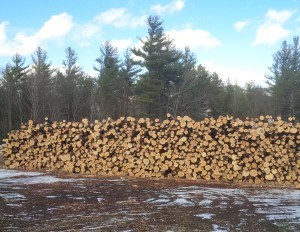Not All Piles of Wood Are the Same

To the untrained eye piles of wood can seem indistinguishable from each other. However when it comes to the selling of wood different standards dictate a number of categories. These categories are determined by a number of different quality and size standards. The prices paid for these products vary based upon what category they fit into.
Below is a list of five main categories by which the wood, harvested from your land, is sorted and sold.
Hardwood Veneer:
This is the most valuable grade of log. The veneer category actually has two subcategories: Slicer Grade & Rotary Grade. To meet Slicer specifications the log has to be clear ( no knots, scars etc..) on all four sides , a minimum of 16” on the tip ( small end of the log) , minimum of 8’6” long and of the following species: Sugar maple, Yellow Birch, Red /White Oak, Walnut and Cherry. Usually only “butt” logs( the first log found on the tree when looking from the base upwards) are able to meet Slicer grade specifications. Because very few logs can meet these standards the amount of money paid for a Slicer Grade Veneer log is very high. It is not uncommon for just one Slicer veneer log to sell for $ 500 -$ 1000.
To meet Rotary specifications the log has to also be clear on all four sides, a minimum of 14” on the tip, at least 8” 6” long and of the following species: Sugar Maple, Yellow Birch, Red/White Oak, Walnut, Cherry, Ash, Aspen, White Birch. Standards are stringent enough that not many logs can fit into this category. This makes the value paid for these logs – pretty high. A full truck load (5800 bd.ft.) of rotary veneer logs can fetch $ 5000.00!
Sawlogs:
Logs that fit into this category are more valuable than pulpwood but not as valuable as veneer. There are saw log markets for both hardwood and softwood species of trees.
- Hardwood: Hardwood saw logs are usually graded according to four different categories. Some markets have five and even six categories – but they are the exception not the rule. The price is determined by what category the log falls into. At a minimum for a hardwood log to meet saw log specification it must be sound, clear on at least two sides of the log, 10” diameter on the tip and 8 feet in length. If it has three clear faces and a larger diameter the price paid is higher. Prices paid also vary based upon the species. For example: the price paid for a Red Oak saw log is going to be much higher than the amount of money paid for a saw log of the Basswood species.
- Softwood: The main softwood species categories here in New England are White Pine, Spruce/Fir and Hemlock. White Pine saw logs are graded according to length, knot size, diameter and the amount of rot in the log. Spruce/Fir and Hemlock saw logs are graded only according to length, diameter and amount of rot present. There are no know knot restrictions for these species.
Pallet:
In New England the only significant market(s) for pallet grade logs are to be found in the hardwood species. This is a category of log that doesn’t meet the grade for saw log but is of higher value than firewood. As a rule of thumb a log has to be at least 9 inches in diameter, straight and sound. For a true pallet market, any hardwood species is acceptable. There are export (Canadian) flooring markets that buy a pallet grade of log, but the only species they will take are Oak, Maple and Birch. At times these export markets can pay significantly higher for this grade of log versus the domestic pallet mills.
Pulpwood:
A harvested tree or processed log that fails to meet any of the above grades is destined to become pulpwood. There are pulpwood markets for both softwood and hardwood. The only rigid specifications for pulpwood is that the wood has to be relatively straight and a minimum of 3’’-5” in diameter. The diameter restriction is based upon each mills specific standard. Lengths vary also according to each mills specific standard. Some mills buy only in 8 foot increments while others purchase pulpwood “tree- length”. Pulpwood purchasing is done on a per ton basis.
Biomass:
In some instances a logging operation will involve the harvesting of biomass. In simple terms biomass are wood chips created by the chipping of wood residue and tree tops If the logging contractor is responsible and conscientious - only the those trees not meeting the above grades and the tree tops themselves will be turned into biomass. Biomass is purchased by weight, and the price paid to the landowner is always very low.
In reality, saw logs even slicer grade veneer can be turned into biomass if the contractor harvesting the timber isn’t doing their job properly. On a side note, I’ve witnessed instances where this has occurred. If the landowner had a professional forester working for them during the harvest this would have been prevented.
Closing:
As you can see, a pile of logs is not just a pile of logs. There are a lot variables that come into play in determining what the wood is worth. Our goal is to see our clients become well informed about the nuts and bolts of forestland ownership. Educating our clients on how logs and timber are graded and paid for is one of the many ways that we work to keep you informed.
Are You Looking for Forest Management Services in New Hampshire or Vermont? Contact Stillwater Forestry Today!